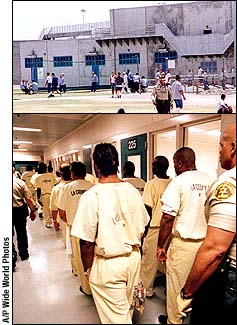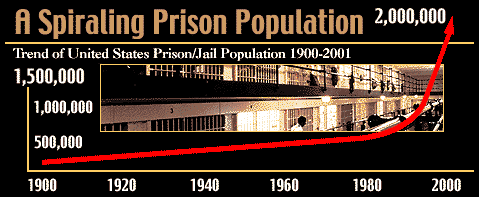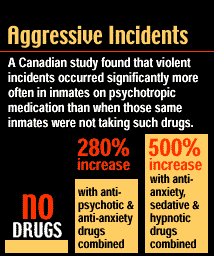
A Solution in America’s prisons has become one of their worst problems

Every 10 minutes, another American disappears behind bars.
By Mark Stout and Thomas G. Whittle

he figures show that 144 inmates a day—roughly 52,000 per year—are being added to our prisons and jails. The number of adult citizens in the system recently surpassed the two million mark. The majority of them—nearly 60 percent nationwide—are repeat offenders; in fact, increased recidivism accounts for the majority of the population growth, jumping by more than 54 percent in state prisons in the last decade alone.

| ||
 |
Medicate vs rehabilitate: Rehabilitation is increasingly being replaced by the one modality that permeates contemporary psychiatry—medication. Estimates report 30 percent or more of inmates are on psychotropic drugs. |
 |
Some have singled out the nation’s drug laws as the cause of the problem and lobby to lighten penalties, particularly mandatory sentencing for personal drug possession and use. However, as Langan points out, the tougher drug and sentencing laws are a later development—enacted in the 1980s—and are not the explanation.
While drug offenders constitute the majority of inmates in federal prisons, they account for one-fifth of the much larger state inmate population. Further, recent statistics showed that violent offenders comprised the majority of inmate growth in state prisons since 1990—51 percent, compared to 20 percent for drug offenders.
The reality is that our prisons are bursting at the seams not so much from new laws, but rather because they have become revolving-door facilities, with many of the same inmates, uncorrected and unrehabilitated, returning again and again.
In examining why so many offenders return, Freedom took a closer look at what happens inside prisons.
While numerous factors contribute to the increasing prison population, one that emerges paramount is an increasing reliance on drugs at all levels of the system to deal with criminal behavior—a solution which has itself become one of the worst parts of the problem.
Rehabilitation Abandoned
A grim aspect of the current situation is that our prison system rarely attempts any longer to rehabilitate. Indeed, it seems many corrections officials themselves have all but abandoned the concept that individuals can be rehabilitated, a tragic mistake compounded each time another man or woman enters the revolving door. Instead, faced with ever-increasing offenders, they have little choice but to warehouse those under their care. Mind-altering drugs—substances documented to actually increase aggression, violence and anti-social behavior—are used liberally to manage and to substitute for vocational training, education and other redemptive efforts.

| ||
 |
A Spiraling Prison Population |  |
The Justice Policy Institute estimates that the annual cost of housing today’s inmates, including the freely dispensed pharmaceuticals, tops $40 billion a year. Although the psychotropic drugs included in this are estimated to cost taxpayers as much as $1 billion annually, Freedom’s investigation found accounting in this regard at both federal and state levels to be obscure.
At the federal level, official records are not available to show just how much of exactly which psychotropic drugs are being given to inmates. However, Traci Billingsley, spokesperson for the federal Bureau of Prisons, told Freedom that from 10 to 15 percent of federal inmates have “a diagnosable mental disorder.”
In an August 2001 article in Corrections Today, Eulon Ross Taylor, M.D., associate professor of psychiatry and mental health director of correctional health care at Texas Tech University Health Sciences Center, doubles that estimate, writing that “between 20 percent and 30 percent of individuals in jails or prisons have diagnosable mental illnesses.”1
Whichever estimate is used, it is obvious that psychotropic drugs are also administered to many other inmates. Billingsley said, “A lot of psychiatric or psychotropic drugs are being given for other things,” such as “migraines or PMS.”
“Many offenders are on various medications without clinical justification,” according to Taylor, noting that the cost of psychotropic drugs is “very high” and that “the cost of treatment can quickly spiral out of control due to the cost of drugs.”
“Let’s Go Get Our Skittles”
The prevalence of drugs is backed up by accounts from inside prisons. “It is now commonplace to see 50—even 60—percent or more of a prison population sleeping in their bunks for 22 hours a day due to the effects of psychotropic drugs they’re being fed like candy,” wrote Daniel Harr, an inmate turned author who has served time in several state prisons.
Harr informed Freedom that the “candy” mentality is seen in one of the more popular sayings behind bars at medication times, with men yelling, “Let’s go get our Skittles,” comparing the colorful pills to the popular candy.

| ||
 |
RISING RECIDIVISM As rehabilitation diminishes and drug use increases, more and more inmates face a grim future in and out of prison. A growing majority of Americans behind bars are repeat offenders. |
 |
Getting the drugs is easy. “The process is: 1) They put in a request to see a psychologist. 2) They have a 5- or 10-minute interview with him, claiming to hear voices or have some other problem. 3) He refers them to the prison psychiatrist and they have another 5- to 10-minute interview. 4) Without any evaluation or testing they’re prescribed basically whatever they ask for.” Many, he noted, “end up pocketing the med and selling it to others.”
The high incidence of psychotropic drugs was echoed in reports to Freedom from other prisoners, correctional officers and social workers.
One critic of the prison system, the Rev. James Meeks, Rainbow/PUSH Coalition executive vice president, recently condemned it as “a feeder system for drugs and AIDS,” charging that sending someone into prison is “like putting a person into a pit of snakes.”
Somewhere, America’s correctional system started into a deadly spiral.
Accelerated Decline
Dr. Thomas Szasz, professor emeritus of psychiatry at the State University of New York (Syracuse) and widely published author, has asked, “If we sincerely desire that prisoners be rehabilitated, so that they become useful members of society, instead of hardened criminals, what is to prevent us from doing so?” Szasz answered by noting “this can be achieved through decent and humane treatment of criminals.”
Though decency and humanity were central to the concept of the first penitentiary*, those qualities disappeared from an ever-harsher system until today, prisons are almost anything but a place in which those who have committed crimes can “pay their debt to society.”
The accelerated decline of the correctional system’s rehabilitation function, today’s prevalence of drugs and the ballooning numbers of those behind bars can be traced in large measure to a “solution” to crime devised in the middle of the 20th century.
Until that time, a crime was a crime, and a more clear-cut concept existed of right and wrong.
 But in 1945, prominent psychiatrist G. Brock Chisholm articulated a new, little-known objective that would have a profound effect on corrections and, indeed, on the entire criminal justice system. The goal, in Chisholm’s words: “The re-interpretation and eventually eradication of the concept of right and wrong... If the race is to be freed from its crippling burden of good and evil, it must be psychiatrists who take the original responsibility.”2
But in 1945, prominent psychiatrist G. Brock Chisholm articulated a new, little-known objective that would have a profound effect on corrections and, indeed, on the entire criminal justice system. The goal, in Chisholm’s words: “The re-interpretation and eventually eradication of the concept of right and wrong... If the race is to be freed from its crippling burden of good and evil, it must be psychiatrists who take the original responsibility.”2
|
Although the changes did not happen overnight, their cumulative effects have been profound.
Treatment Increases Crime
The aim of treating crime as a mental illness achieved a breakthrough in 1954, when a U.S. Court of Appeals decision overturned the criminal conviction of a man for housebreaking on the reasoning that “an accused is not criminally responsible if his unlawful act was the product of a mental disease or defect.”
In ensuing years, more violent criminals and even murderers came to be found guiltless by reason of insanity and placed in the custody of psychiatrists who often, after failing to rehabilitate them, turned them loose upon society. The ranks of those released have included Edmund Kemper, freed by psychiatrists five years after admitting he killed his grandparents; within several years, he went on to murder eight more people, including his mother.
Kemper was interviewed by court-appointed psychiatrists within a week of killing his third victim (a 15-year-old girl), having sex with the dead body, and dismembering it. Unaware of Kemper’s fresh crimes, the two examining psychiatrists gave him a clean bill of health, with one writing, “I see no psychiatric reason to consider him to be of any danger to himself or any other member of society.”3
The many individuals who received psychiatric treatment and who were released from prison or jail only to commit worse crimes include such names as Steven Allen Abrams, Lynwood C. Drake III, Buford Furrow and Patrick Purdy. (See “The deadly cost of a failure to rehabilitate”.)
Despite the failures of psychiatrically based programs, little has been done to establish or to maintain alternate, workable solutions, letting them perish by the roadside along with the ethical and moral values inherent in the “penitentiary” concept. Ultimately, more and more treatment programs have contracted into the one modality that defines contemporary psychiatry—“medication.”
Meanwhile, psychiatrists instilled a mindset among the nation’s educational institutions by indoctrinating them to be alert for children exhibiting signs of “potential delinquency” and to refer them for treatment. Such children are then segregated with labels such as “conduct disorder,” “oppositional defiance disorder” or any number of other labels and treated with drugs in their schools or carted off to school-based health clinics or community mental health centers. These centers also treat members of the community at large and provide almost all of the mental health services for adult and juvenile offenders.
More recently, “jail diversion” programs established in the 1990s have allowed courts to refer people charged with minor crimes to outpatient mental health treatment. “Conflict resolution” classes and “anger management” programs, which claim as their purpose the prevention of crime, are entrenched in today’s schools.
Also in recent years, at least partially in response to the “super-predator”4 theory of youth violence, trends emerged within the justice system to prosecute children and teenagers as adults, to discard rehabilitation in favor of punishment, and to treat offenders more like animals than humans.

| ||
 |
Aggressive Incidents A Canadian study found that violent incidents occurred significantly more often in inmates on psychotropic medication than when those same inmates were not taking such drugs. |
 |
Relevant statistics say no.
The United States, with roughly five percent of the world’s population, houses 25 percent of the prisoners – and also 50 percent of the psychiatric and psychological practitioners.
Since 1970, in fact, prison growth and mental health funding have increased at similarly explosive rates. Between 1970 and 1995, mental health expenditures jumped 770 percent; during the same period, America’s inmate population rose more than 550 percent.
Decades ago, one might have merely looked askance at those who promoted the premise that a criminal was simply “ill.” Yet an abundance of evidence has since surfaced to show that trying to prevent or reform criminality by treating it as a mental illness can actually increase crime. The facts speak for themselves.
More Likely to Commit Crime
Richard Clark Cabot, M.D., professor of social ethics and clinical medicine at Harvard University, was one of the first to undertake a comprehensive study that would demonstrate a connection between psychological treatment and criminal behavior.
The long-range study commenced by Dr. Cabot and his colleagues divided more than 500 boys between the ages of 5 and 13 into two groups. One group underwent psychological counseling for five years beginning in 1939; the other received no counseling. Many years later, researcher Joan McCord studied and compared the general well-being of the 253 men who had received psychological treatment to the 253 who did not. The results were published by American Psychologist in March 1978.
Although most of those in the treatment program said it had helped them, they actually fared worse in each of the areas evaluated. Most significant was the impact of psychological treatment on criminal recidivism. Almost equal numbers in the control and treatment groups committed crimes as juveniles. But the study found that the men from the treatment group were significantly more likely to commit additional crimes during adulthood.
Further, McCord reported that men from the treatment group tended to die younger, were prone to alcoholism, manifested more signs of serious mental and stress-related illnesses, and tended to have unsatisfying occupations.
Aggression Increased on Drugs
When one adds psychotropic drugs to treatment, problems compound themselves. One of the studies that drove this point home, entitled “Effect of Psychotropic Drugs on Aggression in a Prison Setting,” was published in November 1975 in Canadian Family Physician. The authors, D.G. Workman, M.D., and D.G. Cunningham, noted that previous studies had found that release of hostile aggression frequently follows use of benzodiazepines (a class of tranquilizers) and that the release of hostility observed after use of chlorpromazine (Thorazine), chlordiazepoxide (Librium) and diazepam (Valium) had been implicated in acts of murder and suicide.
|
Apparently aware of the tendency of psychiatrists to blame the patient for adverse reactions to treatment, Workman and Cunningham noted, “This seems to disprove any disclaimer that the aggressive incidents occurred because the inmate was anxious and unable to control his frustrations, or would have been aggressive regardless of drug ingestion, since the inmate was better able to control his aggression until he received the psychotropic medication, whereupon the aggressive incident rate almost triples.”
However, the most startling increases occurred when anti-anxiety, sedative and hypnotic drugs were combined, resulting in a nearly 500 percent rise in aggression.
Many other studies over the years have likewise found that psychotropic drugs increase violent, aggressive and self-destructive behavior. Consistent with these are examinations of the arrest rates of individuals who have undergone psychiatric treatment.
One study, conducted by Bruce Harry, M.D., and Henry J. Steadman, Ph.D., published in the August 1988 issue of Hospital and Community Psychiatry, examined arrest rates of people after their first known contact with a community mental health center (which administer psychotropic drugs to the majority of patients) and found that they were nearly double that of the general population. Crime statistics for those released from psychiatric hospitals were even worse.
Drs. Harry and Steadman reported that patients discharged from state mental hospitals in Missouri had arrest rates for homicide and assault up to 28.54 times greater than that of the general population and an arrest rate of up to 2.03 times that of the general population for all offenses.
Another study conducted by a forensic team at the Malcolm Bliss Mental Health Center in St. Louis between August 1973 and March 1974 found that 82 percent of prisoners evaluated had been hospitalized under psychiatric care prior to the commission of their crime.
Fomenting Aggressive, Violent Behavior
Unfortunately, newer treatments and drugs have done nothing to alleviate the problem. A study published last year in Archives of General Psychiatry5 found that people hospitalized for mental illness had higher arrest rates for violent crimes than those not hospitalized.
And then there’s the more recent class of psychotropic drugs, the Selective Serotonin Reuptake Inhibitors (SSRIs)—antidepressants prescribed to treat everything from the blues to compulsive shopping and promoted as being free from the complications that plagued earlier substances.
The harmful effects of SSRIs, reported on since 1989 in Freedom6, are now widely acknowledged. In May 2000, news reports revealed that the patent application for a “new version” of one commonly prescribed SSRI stated that it was formulated in such a way as to eliminate the current drug’s adverse effects (effects long strenuously denied by its manufacturer), ranging from headaches and nervousness to “intense violent and suicidal thoughts and self-mutilation.”7
Several scientific studies and papers have reported that SSRIs can generate aggressive and violent behavior in individuals who take them.
SSRIs are said to achieve an antidepressant effect by preventing the body from metabolizing serotonin, a brain chemical. In so doing, serotonin levels increase. But several decades before the first SSRI was marketed, it was known that interfering with the body’s ability to metabolize serotonin could cause aggressive behavior.
In the mid-1950s, for example, Dr. Felix Sulman, an early serotonin researcher, examined people who had difficulty metabolizing serotonin. He discovered that elevated serotonin levels caused even the most docile of creatures to become aggressive. People unable to break down serotonin “were in effect being poisoned by the serotonin produced by their own bodies.” Sulman coined the term “serotonin irritation syndrome” to describe the condition.8
SSRIs, as well as stimulant drugs (often prescribed for “learning disorders”) and other psychotropic substances, have been linked to a wave of violent crimes, including assaults, rapes and school shootings. Among the countless reported instances of lethal violence committed by individuals known to be on psychiatric drugs are such recent ones as Andrea Yates.
The aggressive, violent behavior caused by these drugs may explain findings in a report published in July 1999 by the Bureau of Justice Statistics. Entitled “Mental Health and Treatment of Inmates and Probationers,” it determined that those who had received mental health treatment were far more likely to have been incarcerated for a violent crime than the general prison population. And although over half of the probationers said to be mentally ill received treatment after their release, they were much more likely to become violent recidivists.
“Too Much of a Security Risk”
Another aspect of the situation is that inmates often turn to alcohol or street drugs for relief from problems created by psychiatric drugs. A Colorado task force established by that state’s legislature to examine mental health issues in the criminal justice system reported in the spring of 2000 that many individuals “on psychotropic medications begin taking alcohol or drugs to combat side effects caused by the psychotropic medications.”9
The task force also reported that a long parade of inmates in both prisons and jails had received counseling, medication or other mental health services prior to committing their crimes.
The parole division of the Colorado Department of Corrections expressed its concern to the task force about the high rate of recidivism among parolees who received mental health treatment.
Although numerous programs have been created to prevent crime by diverting “at-risk” populations into mental health treatment, the number of prison inmates said to have a mental illness today is more than twice the number identified in 1996 and five to six times higher than the number identified in 1988. As labeling swells the ranks of the “mentally ill,” one expert on drugs and their effects noted, “The brain-damaging substances that are administered make recipients less able to cope with life and more prone to aggression and violence—a grim situation that feeds itself and can only worsen so long as labeling and drugs are presented as the ‘solution.’ ”
Evidence also continues to show that, aside from drugs, psychiatric and psychological treatment also contribute to disciplinary problems within the prisons. The Bureau of Justice Statistics report, “Mental Health and Treatment of Inmates or Probationers,” noted that while incarcerated, the majority of those said to be mentally ill received treatment, yet “Mentally ill inmates in federal prison were over twice as likely as others to report involvement in a fight.... [C]onsistent with their more frequent involvement in fights, disciplinary problems were more common among mentally ill inmates than other inmates.”
The problem is so pronounced that one New York City prison official told Freedom that individuals with a history of psychiatric treatment are not allowed in the city’s minimum security prisons. “They are considered too much of a security risk,” he said.
Profiting From Criminality
Even though problems created by psychotropic drug use are widely recognized, the system supported by those substances continues to fatten itself through diagnoses of criminal or delinquent conduct as mental illness.
As an April 2000 report by the Office of Juvenile Justice and Delinquency Prevention stated, “it is not uncommon for 80 percent or more of the juvenile justice population to be diagnosed with conduct disorder.”
The Colorado task force directed to study mental health matters in that state’s criminal justice system provided insight into just how much money there is to be made by redefining crime as an illness. Its report stated that taxpayers pay an additional $300 to $800 per month for each person in community correctional facilities on psychotropic drugs.
Perhaps that is why, from the fiscal year beginning July 1, 1991, through the fiscal year ending June 30, 2000, the administration of psychotropic medications in the Colorado Division of Youth Corrections increased by 988 percent.10
Accounting and Follow-up Needed
Traci Billingsley of the federal Bureau of Prisons said that the bureau did not have a breakdown of drugs administered to inmates, nor did it have a budget category to show how much is being spent on them.
She said, however, that the bureau expected to establish a pharmaceutical data base within a few months “that will actually, from here, be able to look up any kind of meds and know how many people in the agency are prescribed that med.” When Freedom called back several months later, however, a bureau spokesman said that such a data base was “still under review” and that “a variety of things have come up” to forestall activation, such as funds.
While the costs of psychotropic drugs may be buried in prison budgets, Medicare, Medicaid or other funding streams, one fact is certain: they are increasing. The states of Washington and Wisconsin recently reported that drug costs for prison inmates, which includes a number of psychotropic substances, more than doubled in recent years.11
But why should the taxpayer have to guess? Full public disclosure of expenditures and results is essential—including a means of following all inmates administered drugs, especially those substances known to cause aggression and violence. But more so, the solution lies in reapportioning funds currently being used on chemical balls and chains to drug rehabilitation, education and vocational training for inmates.
Had the countless billions of dollars already poured into prison mental health programs actually produced results—yielded citizens capable of getting along in society, more stable and less desirous of abusing drugs or alcohol—America’s prison population would be declining.
Instead, “treating” criminality with drugs is creating far more problems than it is solving.

